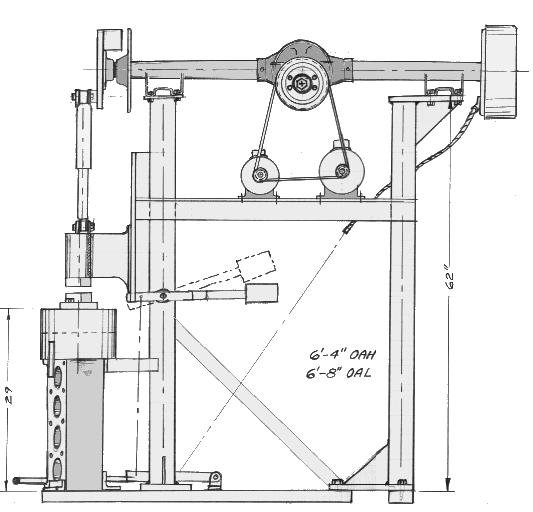

The curious lever and counter balance (center behind anvil) is to prevent the dies from contacting or "clacking" on start up. The lever drops clear when the treadle is depressed and also acts as a treadle return.
NOTE: This device was not built on the actual EC-JYH. It was deemed too complicated to debug and we were running a tight schedule to complete the machine.
Ideally the rear column would be directly under the axle flange. After looking at this ugly mess I think I am going to use a new different attachment method and put a vertical column at the back of the base plate (More iterative design). The extra overhang will not be detrimental to the axle as it is only supporting a small part of its own weight when it was designed to carry approximately. 1,000 pounds. Will probably use a V-block and U-bolt design to avoid welding to the axle tube.
NOTE: The actual solution was to set the rear beam at an angle (see finished photos). This took some careful layout but was one of those things that worked better in the doing than in the planning.After all this, we had surprise when we went to assemble the hammer. The differential housing is not parallel to the spring flanges. It points downwards at about a 5° angle! This is so that when under load the torque tips it up on the springs and aligns the diff. with the drive shaft! Lots of washers were required to level up the axle on our nice square flanges.
Even when you measure everything as carefully as possible there are always the features you didn't think of measuring!
The dual motors are being used to get the horsepower up while keeping the cost down. If purchasing a NEW motor one would be cheaper, but when scrounging for used motors 1 or 1-1/2 HP single phase motors are hard to come by. One advantage of the dual motor design is that motors draw a huge amount of electric current on start-up. This is called in-rush current and is what makes your lights flicker when a motor starts. By using two switches and starting the motors one at a time more horsepower can be drawn from a given circuit. It is also possible to use ONE motor with a burnt out start winding (a common failure of single phase motors). REAL junk yard stuff!
IMPORTANT! To use dual motors the motor pulleys must be the exact same diameter. These will be our last NEW purchased item.
The dimensions here are for reference purposes only and ARE NOT applicable to any other construction.
When this machine was being built it was part of a challenge. Everyone said "shocks" wont work. The competition was using spring linkage, we were not.
We proved shocks DO work. . . sort of. The shocks make a quick and dirty linkage but they are terribly inefficient. Instead of adding to the velocity of the blow they take away from it. We had to slow the hammer down by 50% because at the higher speed the shocks caused the ram to "float" above the work. At the final working speed of about 140 blows per minute the hammer had a very soft touch. And to get that we had to double the ram weight from the planned 33 pounds (15 kg) to over 60 (+27 kg). This made it great for delicate work or chasing.
The shocks gave the hammer the capacity to automatically compensate for a change in working height of up to 8" (~200mm). However, because all modern shocks are gas filled (and act like a spring, I learned) the dies close tightly between operations. This makes the first blow a very hard one, and then the rest get softer.
That makes the logic of this hammer completely backwards from any other. The faster it runs the softer it hits.
Even though it is not a work-horse steel drawing machine, it will still outwork a man in any given hour. So, build a shock absorber hammer if you like. Its fun and inexpensive to do.